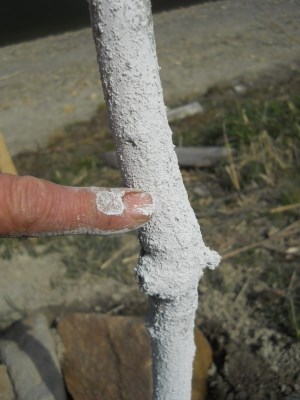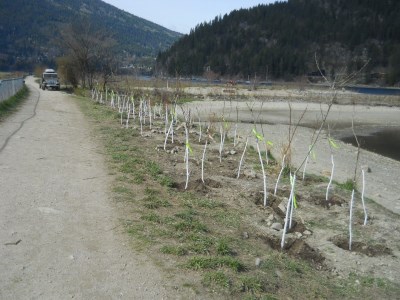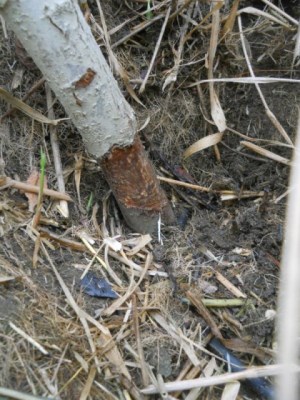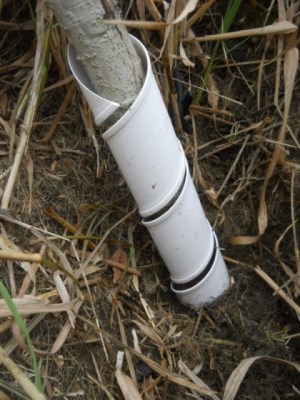There are a number of agents that can damage your rooted / unrooted cuttings after planting. This section deals measures to protect plants from these agents.
Beaver
Potential damage to planted Cottonwood, Willows or Red-osier dogwood by beaver is a often major concern in riparian areas. One solution is to fence-off treatment areas to keep beaver out. For smaller projects this works well, but it is costly and does require maintenance.
Another way to reduce or prevent beaver damage that’s proving itself very effective in our riparian projects is the use of what’s called a “textural repellent.” This is simply a mixture of coarse sand and latex paint applied to the stems. Scientific research has been done to support this approach.
The USDA National Wildlife Research Center (see ref. 1 below) reported the results of a 2-week beaver pen (enclosure) study that tested the effectiveness of a coarse sand/paint mixture applied to cottonwood stems. Untreated stems were severely damaged during this study; however, eight out of the ten study beavers completely avoided stems treated with a coarse sand/paint mixture. Damage to treated stems by the other two beaver was very limited. Shoots sprouted through the sand/paint coating without any problem – Note .. I have found the same thing, the paint/sand coating does not impede shoot formation.
The application of a textural repellent (sand/ paint mixure) is recommended when beaver inhabit the planting location.
A mixture of coarse sand and latex paint was applied to this willow stem. Here a light grey paint was used, although I prefer to use white paint as this also protects the stems from sun-scald.
The lower stem of these willow and dogwood TRS Cuttings has been coated with a paint (white) / sand mixture (2013 Nelson Earthday Event).
Directions:
Mix about 1½ cups of medium to coarse sand per liter of latex paint. Mixture should be heavily laden with sand, but too much will cause it to flake off when being applied. Stir vigorously every 5 min or so while applying.
Don rubber gloves and use a small rag or sponge to apply the paint / sand mixture to stems (much faster than a brush). Best applied after planting as the dried paint/sand coating is easily rubbed off with handling. Place a drop cloth (old bed sheet works well) around the stems when applying to catch drippings.
Consider the water level around the plants during peak flood periods; it may be necessary to protect the top portion of stems as well.
Other Measures
Vinyl Tree protectors – see Preventing damage from ungulates – can also be used to protect stems from beaver. Due to the stem height requiring protection (min 3′ in the case of beaver), this treatment is costly and when applied over a larger area somewhat unsightly. When the plants are well established and producing basal shoots, these vinyl protectors should be removed.
There are also chemical animal repellents available, however these may be severely restricted from use in riparian areas (see ref. 1 below).
Preventing Ungulate Damage
Damage to willow, cottonwood and dogwood stems from foraging ungulates can be severe in some areas. It is thought that by planting very tall TRS Cuttings (up to 3 m +), new shoots may be placed out of reach of browsing.
The main stem (which ungulates often like to bark-strip for food during the winter) can be protected with a paint / sand textural repellent – my observations indicate this can be effective at reducing or preventing this type of damage.
Another type of ungulates damage that can be extensive is damage due to antler polishing by males, occurring in the fall months. Here I have used vinyl tree protectors placed to a height of 4-5 feet – costly and expensive. More on this soon ..
Vole
Small rodents such as vole may feed on bark at base of stems of willow, cottonwood or dogwood, potentially causing plant mortality. In the case of voles, it appears the problem is greatest in areas with a heavy grass cover.
Vinyl tree protectors are one means of preventing such small mammal damage. They are inexpensive and come in lengths of up to 3′ (easily cut with good scissors).
Vole damage on sitka willow stem (TRS Cutting) in heavy Reed Canary grass.
Spiral Tree Protector ring installed to protect base of willow stem. Sink the bottom of the protector down into the soil some.
These tubes should be removed once the plant is well established (e.g., 3-4 years).
As some of the vole damage seen (area in above photos) was on stem portions where a paint / sand textural repellent was applied, this repellent seems ineffective for these small animals.
Sun Scale
The stems of TSR cuttings can experience sun scald, especially on warm aspects. Brushing diluted white latex paint (50% paint / 50% water) on the south side of the stems will prevent this. This paint should be applied at the time of planting.
Reference Cited
Header Image: Beaver teeth marks on a young Cottonwood.




